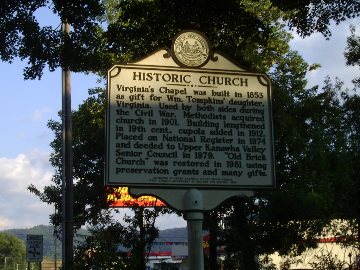 Anyone who knew me back in school would be amazed to learn that I LOVE history. But that fascination didn't come from the history books I was issued in school. It grew over time as I traveled about and discovered unique, fascinating, unheralded places. For years I lived on the shore of Maine and had a view of several small islands from my home. Then I discovered a book that told of how that island had people living on it BEFORE the Pilgrims arrived in Boston. Really? How come I never heard that before? I sailed out one day to check it out, and one of my upcoming book ideas was launched. I grew up near Boston, but it wasn't until I was researching for another book that I discovered tons of interesting, previously unknown places, with fascinating stories to tell. I've now been around the world and everywhere I go, there are places filled with interesting tales that never make it into the standard history books. When I see a sign like this, I stop to check it out - you just never know what interesting, obscure or important piece of history you might discover. I thought I'd share a few of my fun finds with you here.
Anyone who knew me back in school would be amazed to learn that I LOVE history. But that fascination didn't come from the history books I was issued in school. It grew over time as I traveled about and discovered unique, fascinating, unheralded places. For years I lived on the shore of Maine and had a view of several small islands from my home. Then I discovered a book that told of how that island had people living on it BEFORE the Pilgrims arrived in Boston. Really? How come I never heard that before? I sailed out one day to check it out, and one of my upcoming book ideas was launched. I grew up near Boston, but it wasn't until I was researching for another book that I discovered tons of interesting, previously unknown places, with fascinating stories to tell. I've now been around the world and everywhere I go, there are places filled with interesting tales that never make it into the standard history books. When I see a sign like this, I stop to check it out - you just never know what interesting, obscure or important piece of history you might discover. I thought I'd share a few of my fun finds with you here.
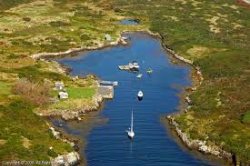 Damariscove Island - How many of you folk have heard of Damariscove, Maine? I thought so! It’s an island off the coast of Maine, a mere two miles long and barely a quarter mile wide, but a colony of European fishermen and traders were established here as far back as 1604 and some records suggest even 1581. That’s not as old as St Augustine (founded in 1565) but it’s quite a few years before Jamestown, Virginia or Plymouth, Massachusetts. In fact, Capt. John Smith found Damariscove a busy place when he stopped there in 1614 and in 1622 when the hungry Pilgrims sent Edward Winslow out begging for food, they were given over 400 pounds of salted cod to take back to their starving colony. In Winslow’s journal he noted there were thirty ships of sail in Damariscove’s narrow harbor. That seems like a pretty substantial community to me, in spite of the fact that our history books never mention the place. Even the Mayflower had seen Damariscove Harbor before setting out to deliver the religious Pilgrims to the new world. She had been there to haul loads of salted cod back to Europe.. Click on image to read story.
Damariscove Island - How many of you folk have heard of Damariscove, Maine? I thought so! It’s an island off the coast of Maine, a mere two miles long and barely a quarter mile wide, but a colony of European fishermen and traders were established here as far back as 1604 and some records suggest even 1581. That’s not as old as St Augustine (founded in 1565) but it’s quite a few years before Jamestown, Virginia or Plymouth, Massachusetts. In fact, Capt. John Smith found Damariscove a busy place when he stopped there in 1614 and in 1622 when the hungry Pilgrims sent Edward Winslow out begging for food, they were given over 400 pounds of salted cod to take back to their starving colony. In Winslow’s journal he noted there were thirty ships of sail in Damariscove’s narrow harbor. That seems like a pretty substantial community to me, in spite of the fact that our history books never mention the place. Even the Mayflower had seen Damariscove Harbor before setting out to deliver the religious Pilgrims to the new world. She had been there to haul loads of salted cod back to Europe.. Click on image to read story.
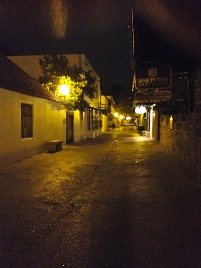 Historic St Augustine - Oldest City in the United States: How many of you read that Jamestown was the first European settlement in the US? And that the Pilgrims were the first permanent settlers? Well, you and the books you learned that from were wrong. You might already have read about Damariscove (Above) which was around quite a few years before the Pilgrims arrived at Plymouth, Massachusetts. But even they weren't the first. There was a small colony of French settlers at Fort Caroline close to present day Jacksonville, FL, but they were wiped out by the Spanish who settled St Augustine in 1565. That's 55 years before the Pilgrims stepped foot in the new world. One of the most fun parts about living here is that this city loves to celebrate it's history. Every month there's another re-enactment: Searles Pirate raid, Drakes raid, British Watch, Spanish Watch, The landing of Pedro Menendez and more. And there's always the Castillo de san Marco to explore, built in the 1600s and the Fountain of Youth which stands on the very place the first city of St Augustine stood. Ponce de Leon might not have found that youthful spring, but Menendez did plant the first settlement here that flourished. We recently celebrated our 450th birthday. Come on down and check out out-
Historic St Augustine - Oldest City in the United States: How many of you read that Jamestown was the first European settlement in the US? And that the Pilgrims were the first permanent settlers? Well, you and the books you learned that from were wrong. You might already have read about Damariscove (Above) which was around quite a few years before the Pilgrims arrived at Plymouth, Massachusetts. But even they weren't the first. There was a small colony of French settlers at Fort Caroline close to present day Jacksonville, FL, but they were wiped out by the Spanish who settled St Augustine in 1565. That's 55 years before the Pilgrims stepped foot in the new world. One of the most fun parts about living here is that this city loves to celebrate it's history. Every month there's another re-enactment: Searles Pirate raid, Drakes raid, British Watch, Spanish Watch, The landing of Pedro Menendez and more. And there's always the Castillo de san Marco to explore, built in the 1600s and the Fountain of Youth which stands on the very place the first city of St Augustine stood. Ponce de Leon might not have found that youthful spring, but Menendez did plant the first settlement here that flourished. We recently celebrated our 450th birthday. Come on down and check out out-
click picture of St George Street at night.
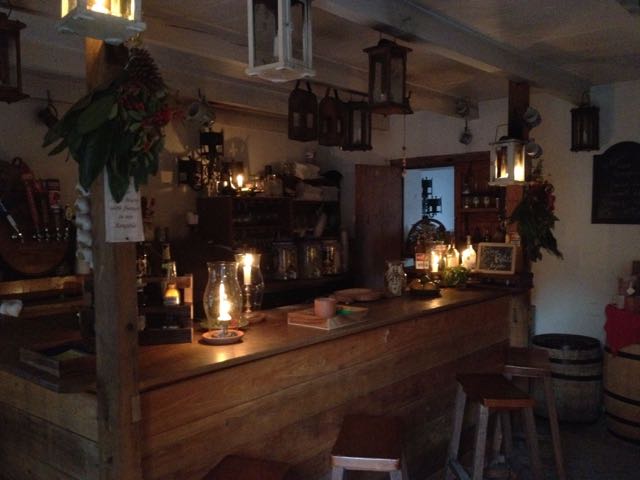 Taberna Del Gallo - in the heart of St Augustine - was, when I first saw it, an experience from the past. Walking in the door felt like traveling back in time. Lit only by candles and lanterns, you could sit on a stool and order a beer, or a sangria and listen to the barkeeps weave stories about St Augustine's past and it felt like you were there. Sadly this fascinating place was taken over by a man intent on modernizing and making money with little interest in the history it once represented. But when I worked there dressed as a 18th century Spanish tavern wench, we had a lot of fun. Captain Mayhem, a local pirate, stopped in often and now and then the Bilge Rats would spend an evening singing old sea chanties. We were raided once by Searles' men who carried off some of the ladies there during a re-enactment, and we celebrated a wedding, too. It was a fun place to work.
Taberna Del Gallo - in the heart of St Augustine - was, when I first saw it, an experience from the past. Walking in the door felt like traveling back in time. Lit only by candles and lanterns, you could sit on a stool and order a beer, or a sangria and listen to the barkeeps weave stories about St Augustine's past and it felt like you were there. Sadly this fascinating place was taken over by a man intent on modernizing and making money with little interest in the history it once represented. But when I worked there dressed as a 18th century Spanish tavern wench, we had a lot of fun. Captain Mayhem, a local pirate, stopped in often and now and then the Bilge Rats would spend an evening singing old sea chanties. We were raided once by Searles' men who carried off some of the ladies there during a re-enactment, and we celebrated a wedding, too. It was a fun place to work.
But click on the image to find out more.
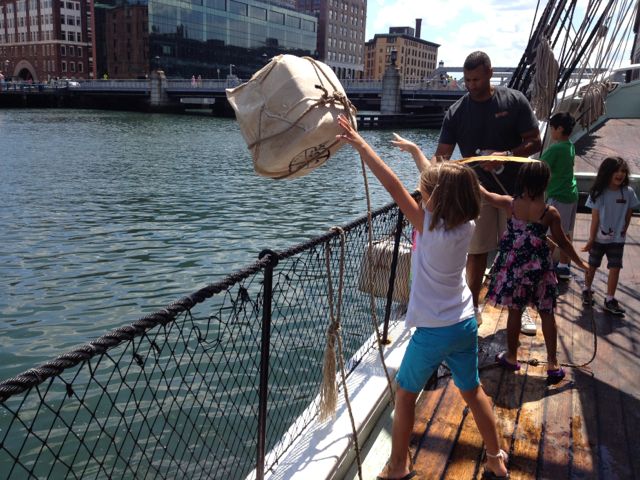 The Boston Tea Party - A relatively new museum in Boston sits right in the middle of the Charles River with two replicas of 18th century merchants flanking it. When you start the tour, you are seated in a meeting room straight out of Boston History listening to Sam Adams rousing the citizens of Boston to revolt against the tea tax. Then you get to be part of the history. My granddaughters' favorite part of the experience was getting to toss bales of tea into the river, but the rest of the tour was just as fun. At the meeting with Sam Adams a number of visitors get to play a part. When the tour is over, we all stopped into Abigail's Tea House to have so real tea and lovely pastries.
The Boston Tea Party - A relatively new museum in Boston sits right in the middle of the Charles River with two replicas of 18th century merchants flanking it. When you start the tour, you are seated in a meeting room straight out of Boston History listening to Sam Adams rousing the citizens of Boston to revolt against the tea tax. Then you get to be part of the history. My granddaughters' favorite part of the experience was getting to toss bales of tea into the river, but the rest of the tour was just as fun. At the meeting with Sam Adams a number of visitors get to play a part. When the tour is over, we all stopped into Abigail's Tea House to have so real tea and lovely pastries.
Click on the image to hear the story.
 The Boston Stone - Having grown up near Boston, I spent quite a bit of time in the city. Riding on the swan boats with my grandmother was the first expedition I remember. Several times I passed this interesting stone sticking out of the side of a building on an out of the way street. What was this rock? And why here? The title and date didn't tell me much. And there was no handy sign marking this as a historic place. I passed it many times and wondered about it before curiosity finally had me hunting down the story. I'm betting there are obscure things like the Boston Stone in cities everywhere - all one has to do is dig a little to find out what the story is.
The Boston Stone - Having grown up near Boston, I spent quite a bit of time in the city. Riding on the swan boats with my grandmother was the first expedition I remember. Several times I passed this interesting stone sticking out of the side of a building on an out of the way street. What was this rock? And why here? The title and date didn't tell me much. And there was no handy sign marking this as a historic place. I passed it many times and wondered about it before curiosity finally had me hunting down the story. I'm betting there are obscure things like the Boston Stone in cities everywhere - all one has to do is dig a little to find out what the story is.
Click on the stone to read all about it.
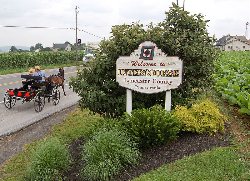 Ever heard of a town called Intercourse? It's in Pennsylvania. I discovered it when I spent a few days to check out a neighboring town called Paradise. Turns out there are a number of interestingly named towns in that part of the state. There's also a fascinating living history village depicting life as it was in the 1800s, complete with a general store, a blacksmith, a tavern and lots more. In the hostelry, they were making bread and had a cauldron of stew simmering over a fire. Sure did smell good. The array of goods on the shelves in the general store was amazing, and at one end of the store a little pot bellied stove with stools around it invited folks to stop and socialized for a bit.
Ever heard of a town called Intercourse? It's in Pennsylvania. I discovered it when I spent a few days to check out a neighboring town called Paradise. Turns out there are a number of interestingly named towns in that part of the state. There's also a fascinating living history village depicting life as it was in the 1800s, complete with a general store, a blacksmith, a tavern and lots more. In the hostelry, they were making bread and had a cauldron of stew simmering over a fire. Sure did smell good. The array of goods on the shelves in the general store was amazing, and at one end of the store a little pot bellied stove with stools around it invited folks to stop and socialized for a bit.
Click on photo to learn more.
 Washington's Crossing We're all familiar with this old painting of Washington crossing the Delaware River, but how many of us know the importance of that historic event? Field trips are the best ever way to enjoy and appreciate our country's history so I sent my granddaughters a historic novel set against this scene. Then I took them to a wonderful park called Washington's Crossing in Pennsylvania right on the banks of the Delaware River. It's a fantastic park filled with history, docents dressed in historic garb and old buildings. It's another chance to step back into a fascinating piece of American History. Click on the well known painting to read all about it.
Washington's Crossing We're all familiar with this old painting of Washington crossing the Delaware River, but how many of us know the importance of that historic event? Field trips are the best ever way to enjoy and appreciate our country's history so I sent my granddaughters a historic novel set against this scene. Then I took them to a wonderful park called Washington's Crossing in Pennsylvania right on the banks of the Delaware River. It's a fantastic park filled with history, docents dressed in historic garb and old buildings. It's another chance to step back into a fascinating piece of American History. Click on the well known painting to read all about it.
 Christopher Sheels - Another great field trip I took my grandkids on was to Mount Vernon, Virginia - the well known home of George Washington. I signed us up for a personal tour - all such tours were with a costumed interpreter who was paying the part of someone who lived at Mount Vernon. We met Christopher Sheels who was George Washington's body servant. What a fascinating story he had to tell. Want to know more about this man who never appears in any history books I ever read? Click on the picture to enter his world.
Christopher Sheels - Another great field trip I took my grandkids on was to Mount Vernon, Virginia - the well known home of George Washington. I signed us up for a personal tour - all such tours were with a costumed interpreter who was paying the part of someone who lived at Mount Vernon. We met Christopher Sheels who was George Washington's body servant. What a fascinating story he had to tell. Want to know more about this man who never appears in any history books I ever read? Click on the picture to enter his world.
 HMS Bounty Unfortunately, this 50 year old replica of the 18th century square rigger, HMS Bounty sand off the cost of North Carolina during Hurrican Sandy. But before that happened she sailed into St Augustine Harbor and I was fortunate to go aboard her. If you'd like to find out more, click on the ship.
HMS Bounty Unfortunately, this 50 year old replica of the 18th century square rigger, HMS Bounty sand off the cost of North Carolina during Hurrican Sandy. But before that happened she sailed into St Augustine Harbor and I was fortunate to go aboard her. If you'd like to find out more, click on the ship.